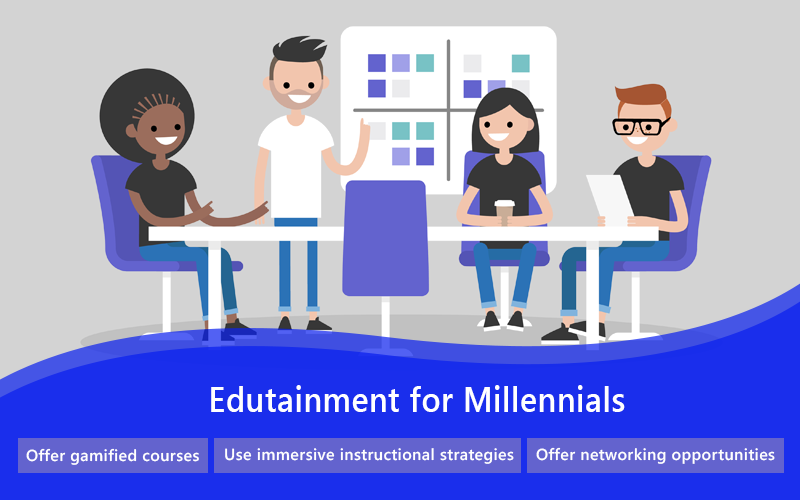4 Quick and Quirky Ways to Infuse Edutainment in eLearning

We all love to be entertained but do have a lot of doubts about combining entertainment with education – “wouldn’t it trivialize the subject matter?”. But the fact is, learners learn better when there is intrinsic motivation for the learning experience via entertainment. Learning combined with entertainment grabs learners’ undivided attention and leads to long-lasting learning impact. This blog explores how eLearning can help strike this balance.
Download this eBook if you are looking to outsource eLearning design and development.
eLearning for Edutainment
4 quick ways to infuse the entertainment factor in your eLearning courses:
- Gamification
- Game-based learning
- Storytelling
- Social and collaborative learning
‘Edutainment’, a unique integration of education and entertainment uses various engaging techniques to impart knowledge. It is mainly used to provide a motivating learning environment for successful training. Let’s now look at 4 quick ways to infuse your eLearning courses with entertainment.
4 Quick Ways of Incorporating Edutainment in Your eLearning
1. Gamification
Won’t learning in a playful, spirited manner be more effective than monotonous ‘click next’ courses? Gamification uses game mechanics such as points, levels, scoreboards, badges, trophies, certificates, or an hour-glass timer in an eLearning course. Education and entertainment are merged where learners learn while playing and achieve the desired learning objectives.
The learning environment is kept completely relaxed and learners won’t be bored by the seriousness of training. Gaming elements generate interest and capture learners’ attention. Scoring a point, finishing a level, earning a badge, all act as motivators for better performance.
For example, in a product training course, when a learner identifies the various product features correctly within the stipulated time, he may be awarded the title “Product Master”. Names of learners with the most titles may also be displayed on the leaderboard, encouraging healthy competition and a sense of achievement.
2. Game-based Learning
What if your entire eLearning course is a game? Learners must play the game to learn. In game-based learning, the game itself is the training. Learning objectives are met when learners learn while playing the game. An immersive learning environment is generated, smartly merging education with entertainment.
For example, an eLearning course on electrical safety can be designed in the form of a treasure hunt where learners have to figure out ways of overcoming obstacles to reach the treasure (LOs in this case, are the different safety measures in different situations). Each hurdle might reveal new information on the relevant topic, adding to the knowledge the learner acquires.
Let’s look at some best practices to design effective game-based learning:
- Keep the entire game, storyline, characters closely aligned to the learning objectives.
- Base the game rules as per your performance, conditions, and criteria.
- Make assessments rewarding.
- Provide immediate and helpful feedback.
Game-based learning raises the engagement factor of your eLearning course; learners explore facts, navigate freely, and they fail or succeed in a risk-free setup. Also, gameplay intrigues will require learners to use logic and decision-making skills, which in turn improves their efficiency and confidence in handling real-life situations.
3. Storytelling
Incorporating stories in your eLearning course will make it more interesting – remember your childhood? Through stories you can establish connections, foster empathy, and thus engage the learner. An eLearning course in a story format with characters the learner can relate to will keep him hooked throughout the course. A few building blocks of stories are:
- Strong storyline relevant to the training content
- A protagonist/hero
- An antagonist (can be in the form of obstacles/unfavorable circumstances)
- Hero’s struggle, suspense, and how he overcomes it
Let’s take an example of a new hire induction eLearning course. The protagonist on his first day of job comes to office full of apprehensions. However, as soon as he steps in, the receptionist welcomes him with a smile and shows him how to login using the bio-metric system.
Moving on, the HR executive takes him through various the departments and shows his desk. The team manager introduces him to other team members. You can then unfold the story as he is guided by peers during the initial days of struggle. Finally, you can close your story with the climax that after 3 months of his joining, he successfully starts contributing toward the business goals.
Within a story world, employees dwell in a scene where characters are as multi-dimensional as them, exchanging real-life dialogues and facing similar problems. Learners get pulled into the course and learning happens along with the characters unconsciously as the story progresses.
4. Social and Collaborative Learning
Remember your days in school, how the idea of group studies excited you! Apart from being engaging, the transfer of knowledge through sharing is much more effective. In the same way, an effective and entertaining method of learning in a group is social or collaborative learning. According to a survey by Brandon Hall Group, 85% of organizations are experimenting with the concept of social learning.
- Online forums or virtual discussion panels can provide scope to interact and express innovative ideas with like-minded learners or peers.
- Expert advice can be sought via online chatrooms.
- Links of relevant resources in the form of embedded videos, podcasts, interactive PDFs, quizzes, or webinars can be uploaded in your learners’ online community.
This provides employees learning opportunities after and outside the actual training. Your LMS may also be used to share links of recent industry reports or micro courses, providing round the clock access and updates in a stress-free manner. Learners can indulge in meaningful dialogues regarding a policy or propose business solutions. The free flow of ideas will help in collaboration and help knowledge retention.
Final Thoughts
Implementing these ideas will ease the challenge of dealing with reduced learner attention. Entertainment with education doesn’t trivialize eLearning; rather, it fosters a welcoming, engaging, and relaxed learning experience. Learners feel a high degree of involvement when the eLearning is entertainment-based and the biggest benefit of this is higher retention level of knowledge.
Now that you know the various methods that will add the entertainment factor to your eLearning courses, are you worried you lack the in-house expertise to get this done? If you don’t have in-house expertise and resources, you can outsource your eLearning design and development to competent, experienced vendors. Gain insights on selecting the right partner, building a win-win relationship, overcoming cultural barriers, and more about eLearning outsourcing in this live webinar.


![5 Tips to Craft a Good Story in Online Courses [Infographic] 5 Tips to Craft a Good Story in Online Courses [Infographic]](https://blog.commlabindia.com/hs-fs/hubfs/Imported_Blog_Media/tips-to-craft-a-good-story-in-online-courses-infographic-1.png?width=900&height=4100&name=tips-to-craft-a-good-story-in-online-courses-infographic-1.png)


![Empowering Your Wallet: Embrace eLearning for Financial Education[Infographic]](https://blog.commlabindia.com/hubfs/blogs/Empowering-Your-Wallet-Embrace-eLearning-for-Financial-Education%5BInfographic.jpg)
